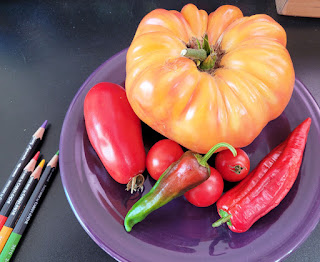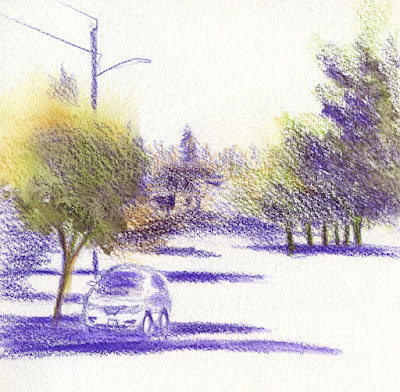 |
| 9/26/22 Caran d'Ache Museum Aquarelle pencils on Canson XL 140 lb. paper |
Alice, our friend and neighbor, has done it again. Sometimes
it’s plums, sometimes it’s tomatoes, but whatever comes from her
garden is amazingly delicious as well as gorgeous. This year one of her
tomatoes was the size of a pumpkin! She was about to hand it to me when I
admired the equally beautiful chili peppers on her kitchen counter, especially
one with both red and green streaks. She knows we don’t eat hot peppers, but
she offered to lend me a few to sketch, which I happily accepted. I gave them
back as soon as I finished the sketch, but you can bet we kept and enjoyed the
tomatoes she gave us.
 |
| I wanted to show a photo of that tomato next to the pencils so you can see how huge it is! |
Believe it or not, I was trying to be looser and more painterly than I have been with some tomato still lives and get away from the botanical study look, but that’s always a challenge for me. At least I did not carefully draw each one of those highlights as I often have. Instead, I roughly marked where they were on each piece, applied the first layers of color, and then activated without trying to “draw” too much with the brush.
The other challenge was the purple plate. After finishing most of the sketch, I left the plate for the next day so I could think about what to do with it. Drawing it to the same degree of realism as the produce would detract, I thought, and I’ve been disappointed when I’ve done that in other still lives. This time, I tried leaving the plate “sketchy” and unfinished looking. I’m not sure about this look either, but I do like the interesting gray shadow I got by mixing the green and violet.























































